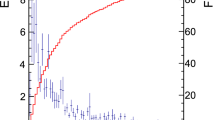Abstract
An empirical approach is presented for reconstruction of the extensive air shower (EAS) cascade curve according to data of the Cherenkov track detector. The proposed method, unlike conventional ones, is based on experimentally measured parameters and on calculated values which weakly depend on the model of shower development.
Similar content being viewed by others
References
V. P. Artamonov et al., “Current Status and Perspectives of the Yakutsk Extensive Air Showers Array,” Izv. Akad. Nauk, Ser. Fiz. 38(12), 92–97 (1994).
A. E. Chudakov et al., “Cherenkov Radiation of Extensive Air Showers,” Nuovo Cimento 8, 606 (1958).
M. N. D’yakonov, “Relation of Some Parameters of Longitudinal Development of EAS with Characteristics of Their Cherenkov Radiation,” in Cosmic Rays of Ultrahigh Energy, Collected Vol. (Yakutsk, 1979), pp. 113–120 [in Russian].
V. M. Grigor’ev and Yu. A. Nechin, “Study Method of Shower Cascade in Atmosphere on Measurement of Impulse Shape of Extensive Air Showers Cherenkov Radiation,” in Cosmic Beams with Energy up from 10 17 eV, Collected Vol. (Yakutsk, 1983), pp. 48–54 [in Russian].
V. M. Grigor’ev et al., “Reconstruction of Cascade Curve by the Data of Synchronous Measurement of the Amplitude and Temporal Characteristics of EAS Cherenkov Radiation by the Method of Inverse Problem,” in Problems of Nuclear Physics and Cosmic Rays, Collected Vol. (Kharkov, 1989), No. 32, pp. 28–30 [in Russian].
I. V. Doronina et al., “Study of EAS Longitudinal Development with E > 1017 eV on Cherenkov Light Amplitude and Temporal Characteristics,” in Proc. of the 2th ICRC (Moscow, 1987), Vol. 6, p. 1143.
V. M. Grigor’ev et al., “Longitudinal Development of EAS by Amplitude and Temporal Structure of Shower Cherenkov Radiation,” in Extensive Air Showers of Energy above 10 17 eV, Collected Vol. (Moscow, Yakutsk, 1987), pp. 61–68 [in Russian].
G. K. Garipov and B. A. Khrenov, J. Phys. G: Nucl. Part. Phys. 20, 1981–1988 (1994).
Yu. F. Fomin and G. B. Khristiansen, “On the Shape of the Cherenkov Radiation Impulse of the Wide Atmosphere Shower,” Yad. Fiz. 14, 642–646 (1971) [Sov. J. Nucl. Phys. 14, 360 (1971)].
G. K. Garipov et al., “The Cherenkov Track Detector Consisting of the Yakutsk Complex EAS Array,” in Proc. of the 27th ICRC (Hamburg, Germany, 2001), Vol. 3, pp. 885–887.
V. V. Zuev, A. V. Elnikov, and V. D. Burlakov, Laser Probing of Middle Atmosphere (Raska, Tomsk, 2002) [in Russian].
I. Knapp and D. Heck, Extensive Air Shower Simulation with CORSIKA: A User’s Guide, Version 5.61 (Karlsruhe, 1998), p. 67.
N. P. Il’ina, N. N. Kalmykov, and V. V. Prosin, “Cherenkov Radiation and EAS Parameters,” Yad. Fiz. 55, 2756 (1992) [Phys. At. Nucl. 55, 1540 (1992)].
Author information
Authors and Affiliations
Additional information
Original Russian Text © V.M. Grigor’ev, 2008, published in Pis’ma v Zhurnal Fizika Elementarnykh Chastits i Atomnogo Yadra, 2008, No. 5 (147), pp. 766–776.
Rights and permissions
About this article
Cite this article
Grigor’ev, V.M. A new method for observing the shower cascade profile at the Yakutsk EAS array. Phys. Part. Nuclei Lett. 5, 456–461 (2008). https://doi.org/10.1134/S1547477108050099
Received:
Published:
Issue Date:
DOI: https://doi.org/10.1134/S1547477108050099




